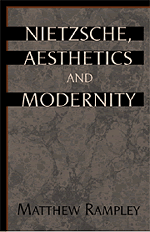Book contents
- Frontmatter
- Contents
- List of Abbreviations
- Acknowledgements
- Introduction
- 1 Truth, Interpretation and the Dialectic of Nihilism
- 2 Nietzsche's Subject: Retrieving the Repressed
- 3 Laughter and Sublimity: Reading The Birth of Tragedy
- 4 Wagner, Modernity and the Problem of Transcendence
- 5 Memory, History and Eternal Recurrence: The Aesthetics of Time
- 6 Towards a Physiological Aesthetic
- 7 Art, Truth and Woman: The Raging Discordance
- 8 Overcoming Nihilism: Art, Modernity and Beyond
- Notes
- References
- Index
7 - Art, Truth and Woman: The Raging Discordance
Published online by Cambridge University Press: 18 March 2010
- Frontmatter
- Contents
- List of Abbreviations
- Acknowledgements
- Introduction
- 1 Truth, Interpretation and the Dialectic of Nihilism
- 2 Nietzsche's Subject: Retrieving the Repressed
- 3 Laughter and Sublimity: Reading The Birth of Tragedy
- 4 Wagner, Modernity and the Problem of Transcendence
- 5 Memory, History and Eternal Recurrence: The Aesthetics of Time
- 6 Towards a Physiological Aesthetic
- 7 Art, Truth and Woman: The Raging Discordance
- 8 Overcoming Nihilism: Art, Modernity and Beyond
- Notes
- References
- Index
Summary
Compared with the artist the appearance of the scientific man is actually a sign of a certain damming up and lowering of the level of life (– but also of strengthening, severity, hardness, will to power).
(WP §816)Despite his recurrent emphasis on affirmativity and his numerous criticisms of cultural pessimism, Nietzsche's aesthetic theory can, in many respects, be regarded as an aesthetics of negation. As such it exemplifies his emphasis on the productive function of the negative. His formulations frequently take on the character of reverse images of the inherited tradition of the philosophy of art. Hence, Nietzsche's physiological aesthetic emerges in opposition to the formalist notion of the autonomy of art. Similarly, Dionysian classicism is shaped in opposition to what Nietzsche perceived to be a disintegration of style characteristic of modernity. Lastly, he conceives of art in opposition to the scientific-metaphysical concern with truth. The object of Nietzsche's criticisms is a constellation of aesthetic notions which find their origins in Kant and Hegel. This is hardly surprising, for it has been suggested that the entire discourse of aesthetic theory up to the present is largely framed by Kant and Hegel, who constitute the two dominant poles of aesthetic thought. On the one hand, Hegel sees art as inextricably linked to the historical evolution of consciousness, functioning as a material symbolic expression of that evolution. Art functions as vehicle of truth, the ‘configuration as a concrete reality’ of the Idea. On the other hand, Kant explicitly dissociates the aesthetic experience from the contingencies of historical consciousness, arguing for an ahistorical aesthetic experience irreducible to conceptual cognition.
- Type
- Chapter
- Information
- Nietzsche, Aesthetics and Modernity , pp. 190 - 214Publisher: Cambridge University PressPrint publication year: 1999



